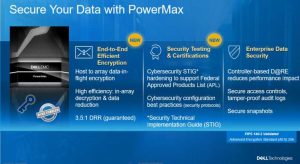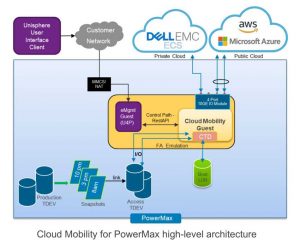Dell Advance Management, Automation and Protection of VMware Environments
HCI, cloud, storage and data protection integration with latest VMware releases help customers innovate across edge locations, data centers and hybrid clouds.
This is a Press Release edited by StorageNewsletter.com on October 5, 2020 at 2:49 pmDell Technologies, Inc. announces several infrastructure portfolio innovations for VMware, Inc. environments, designed to help customers better protect, manage and support traditional and modern applications across edge locations, core data centers and hybrid clouds.
Click to enlarge
“Customers looking to accelerate their digital transformation need trusted, proven solutions that can help them navigate today’s multi-cloud landscape while managing their IT and business needs,” said Jeff Boudreau, president and GM, infrastructure solutions group. “Dell Technologies and VMware are raising the bar with tightly integrated solutions, designed to help customers and partners better manage and protect traditional and modern applications. These latest advancements across our infrastructure portfolio are a testament to our joint commitment to innovation.”
Bringing latest VMware innovations to life
As VMware delivers its latest releases for vSphere, vSAN and VMware Cloud Foundation to support Tanzu, the company is extending support of these technologies across its infrastructure portfolio, with integrated solutions including Dell Technologies Cloud, VxRail, PowerProtect, PowerEdge and more.
VxRail, the jointly engineered HCI the first system with VMware, is the first system to be integrated with vSphere with Tanzu, allowing customers to adopt Kubernetes with automated deployment and provisioning. The company’s infrastructure portfolio lets customers deploy VMware Tanzu in the way that best aligns with their IT strategy, whether through a validated architecture, VxRail cluster and/or the firm’s Cloud Platform.
This Cloud Platform with subscription pricing makes it easy to get started with VMware Tanzu in hybrid clouds for $70 per node, per day.(i) By eliminating upfront costs and forecasting risks, organizations can budget their IT spend without surprises or hidden costs. With fast hybrid cloud deployment, customers can get started in 14 days (ii), and expand deployment in as few as 5 days. (iii)
Click to enlarge
Storage innovations for VMware environments
The company’s storage innovations are designed to help customers manage and access traditional and modern applications in VMware environments:
-
PowerMax simplifies VMware management – PowerMax replication is now integrated with vSphere Virtual Volumes (vVols) and VMware Site Recovery Manager, simplifying VMware management by reducing time needed for provisioning, replication and service level policies. Customers can modernize their infrastructure while protecting their important applications. The Cloud Mobility for PowerMax feature offers simple movement of data from on-premises to public clouds. Customers can reduce the cost per gigabyte for long-term data retention by up to 50% while freeing up capacity for PowerMax to support higher priority applications on-premises, extending the life of the array. (iv) The fast enterprise storage array (v) offers improved security features and Smart DR for data resiliency and efficiency.
Click to enlarge
-
ObjectScale brings object access to VMware Cloud Foundation – The company is previewing its next gen, Kubernetes-based object storage platform, ObjectScale, currently available in an early access program.vi It will allow developers to provision S3-compatible, cloud-scale storage for modern stateful applications on demand. By enabling object storage – a critical component of cloud-native application architectures – to be deployed directly through vSphere, the firm and VMware are equipping customers to deliver modern application experiences and more closely align development and IT operations. Designed with a scale-out, geo-distributed architecture with global accessibility, ObjectScale delivers enterprise storage across edge, core and hybrid cloud environments.
Delivering modern VMware data protection
The company adds advanced management and backup capabilities to PowerProtect Data Manager in VMware environments with the introduction of new data protection updates:
-
PowerProtect Data Manager Support for Tanzu – To help support and protect a customer’s critical modern applications, PowerProtect Data Manager now supports the VMware Tanzu portfolio, including Tanzu Kubernetes clusters, Kubernetes clusters in vSphere, Tanzu Kubernetes Grid (TKG) and Tanzu Kubernetes Grid Integrated (TKGI) on-premises and in public clouds.
-
VMware Storage Policy-Based Management and VMware Cloud Foundation Protection – PowerProtect Data Manager integrations make it the only solution to provide native vCenter Storage Policy-based Management integration for VM protection. This allows (VI) admins to save time by using known workflows from within their vSphere environment to assign data protection policies. Additionally, this latest release of PowerProtect Data Manager offers a VMware-certified solution to protect the VMware Cloud Foundation infrastructure layer.
-
Enhanced protection of mission-critical VMs – The firm is previewing a feature in PowerProtect Data Manager that will eliminate the need to pause a VM during backup. With new snapshot and data movement technologies, teams can backup mission-critical VMs without business disruption. They no longer have to choose between availability and security since all VMs are protected and active, even during backup.
Build clouds faster with Dell Technologies Cloud and VMware
VMware Cloud on Dell EMC, the data center as a service offering for Dell Technologies Cloud, introduces new large node for high memory and storage usage workloads and supports global and vertical industries with critical security needs through compliance certifications, including ISO, CCPA, EU GDPR and SOC-2. The service also simplifies workload mobility with VMware HCX either from legacy infrastructure or between workloads running across two locations. With new multi-cluster support, customers can segment their workloads and create up to 8 clusters in a rack, better utilizing existing resources and increasing performance.
The 2 companies are making it easier for Cloud Service Providers (CSPs) to build and scale hosted cloud environments through tighter integration between VMware Cloud Director and Dell Technologies Cloud Platform (DTCP). Thanks to new integrations, CSPs can enjoy cost savings by reducing the time it takes to provision and manage multi-tenant cloud environments, creating virtual data centers in minutes that can be built once and deployed everywhere ins. New automation capabilities further streamlines service deployment and lifecycle management of the software-defined data center. CSP’s running VMware Cloud Director on DTCP can offer customers rapid access to a more reliable and consistent cloud experience across their DTCP environments and off-premise instances.
Introducing support for VMware Project Monterey
The company is joining VMware in supporting Project Monterey, an applications-driven response to the unprecedented change in how applications are being built and deployed. By adding support for SmartNICs, the 2 companies are providing a path for customers to build next-gen infrastructure that manages the placement of infrastructure, application and security demands across CPUs, GPUs and SmartNICs.
Availability:
-
vSphere and VMware Cloud Foundation with Tanzu on VxRail and Tanzu support for Dell Technologies Cloud Platform will be globally available in October 2020.
-
PowerMax updates are available.
-
ObjectScale early access is coming soon with availability planned in 2021.
-
Support for VMware Tanzu in PowerProtect Data Manager will be available in October 2020.
-
Storage Policy-Based Management in PowerProtect Data Manager will be available in November 2020.
-
VMware Cloud Foundation protection in PowerProtect Data Manager will be available in October 2020.
-
PowerProtect Data Manager functionality that eliminates the need to pause VMs during backup has planned availability in early 2021.
-
VMware Cloud on Dell EMC advancements are available in the US in November 2020.
-
VMware Cloud Director on Dell Technologies Cloud Platform is available.
Lee Caswell, VP, marketing, cloud platforms BU, VMware, said: “VMware and Dell Technologies, together, are delivering solutions that help customers manage traditional and modern applications, whether they reside in a traditional data center, at the edge or in clouds. Today’s announcements from Dell Technologies are the latest examples of the tight integration between our teams, and the benefits our customers see as a result.“
Eric Sheppard, research VP, infrastructure platforms and technologies group, IDC, said: “The demands on IT teams today underscore the need for modern, agile infrastructure. The tight collaboration between Dell Technologies and VMware delivers the feature-rich solutions organizations need to deploy, manage and protect applications everywhere, from the edge to cloud.“
(i) Based on a 3-year term with the minimum starting configuration (4 x 1M1s.small + 3 x 1G1s.sm) and an average monthly price of $2,104. Pricing for DTCP with subscription may vary depending on the number and type of nodes in your configuration.
(ii) Applies to select fixed node configurations. Customer credit approval, site survey and configuration workbook must be completed before order is placed. Excludes orders over 24 nodes, VMware NSX configuration, vRealize (vRA, vRO) components, and some other features. Product availability, holidays and other factors may impact deployment time. US only.
(iii) Applies to select fixed node configurations. Customer credit approval, site survey and configuration workbook must be completed before order is placed. Product availability, holidays, and other factors may impact deployment time. Deployment includes delivery, standardized installation and hardware and software configuration. US only.
(iv) Based on Dell EMC analysis, June 2020. Savings calculated comparing the cost of storing 6 months of Snaps (on average 55% capacity consumed) over 3 years on PowerMax 8000 for 1,246TB vs using Cloud Mobility to store snaps in the AWS Public Cloud on Amazon S3 Standard storage. Costs in dollars. Actual savings will vary.
(v) Based on Dell EMC internal analysis of max bandwidth (64K blocks) of the PowerMax 8000 (350GB/s) vs. maximum bandwidth of competitive mainstream arrays, August 2020. Actual performance will vary.
(vi) Dell EMC ObjectScale Earl
Resources:
Blog: Dell Technologies Advances Storage and Data Protection for VMware Environments
Blog: New Dell EMC PowerMax Updates Push the Boundaries of High-End Storage
Blog: Dell Technologies Teams with VMware on Project Monterey – Next-gen Infrastructure for HCI and Beyond

















 Subscribe to our free daily newsletter
Subscribe to our free daily newsletter

